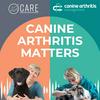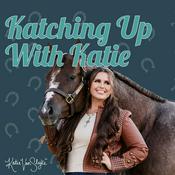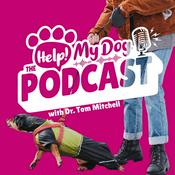65 episodes

Episode 65 - From Reactive to Proactive: A New Model for Canine Health - Matt Gurney
16/12/2025 | 50 mins.
In this episode of Canine Arthritis Matters, Hannah speaks with Dr Matt Gurney about Pawra (https://pawra.com), a new canine wellness centre in Chiswick, London, designed to complement a dog’s primary veterinary care rather than replace it. They explore the growing “wellness gap” between annual vet visits and problem driven consultations, and how Pawra aims to fill this space with evidence informed services focused on prevention, rehabilitation and early detection.Matt explains Pawra’s 90 minute Wellness Assessment (https://pawra.com/wellness-assessment/), the four pillars of care (Stay Well, Stay Fit, Stay Sharp, Recover), and why clear referral pathways and collaboration with a dog’s own vet are essential for safe and effective care. The conversation then moves into osteoarthritis, covering diagnosis, muscle assessment, physiotherapy, environmental changes and why proactive care is critical for long term quality of life.Guest bioDr Matt Gurney is a UK based veterinary anaesthetist and analgesia specialist. He trained at the University of Liverpool, works at Eastcott Referrals (https://www.eastcottreferrals.co.uk), and is Veterinary Lead at Pawra (https://pawra.com). Matt lectures internationally on pain management, has authored numerous publications in veterinary anaesthesia and analgesia, is Past President of the European College of Veterinary Anaesthesia and Analgesia, and was awarded Fellowship of the Royal College of Veterinary Surgeons for meritorious contribution to clinical practice.5 key takehomes1. Pawra is designed to complement, not compete with, your vet by focusing on personalised prevention, rehabilitation and early issue detection (https://pawra.com/services/).2. The Pawra Wellness Assessment provides structured, practical actions for caregivers, the home environment and the primary vet.3. Pain, physiotherapy and behaviour services should follow referral pathways to ensure the full medical history is considered and patient safety is prioritised.4. Proactive care matters, common issues like dental disease and obesity are widespread and often improveable when identified early.5. Effective osteoarthritis management relies on evidence based frameworks such as the COAST staging tool, accurate diagnosis, muscle assessment, physiotherapy guided exercise, weight optimisation and environmental changes like flooring.Relevant linksPawra website: https://pawra.comPawra services overview: https://pawra.com/services/Pawra centre and facilities: https://pawra.com/our-centre/Pawra contact and location: https://pawra.com/contact-us/COAST resourcesCOAST staging tool PDF:https://assets.elanco.com/0cec44ed-3eaa-0009-2029-666567e7e4de/b2d5f58c-2645-46ad-b5e5-65906b491bf3/COAST%20Printable%20PDF.pdfCOAST publication PDF:https://assets.elanco.com/0cec44ed-3eaa-0009-2029-666567e7e4de/fde5d152-6471-4916-af01-550ae49873c6/COAST_Publication.pdfThe Pain Vet: https://thepainvet.co.ukCAM EssentialsIf you are a caregiver or professional wanting a clear, practical and evidence based framework for recognising osteoarthritis pain and building a management plan with your vet team, explore the Canine Arthritis Essentials course here:https://www.cameducation.co.uk/course/camessentialsLearn more about CAM:Facebook: https://www.facebook.com/CAMarthritisInstagram: https://www.instagram.com/canine_arthritisYoutube: https://www.youtube.com/c/CanineArthritisManagementLinkedIn: https://www.linkedin.com/company/canine-arthritis-management-ltdHave questions send them to: [email protected] tuned to learn how early detection can make a significant difference in managing OA in younger dogs.

Podcast 64 - How do you know when you are doing enough for your arthritic dog? - Chelsea Dawson
09/12/2025 | 1h
In this episode, Hannah and Dr Chelsea Dawson talk about a question many owners quietly struggle with: “When is what I’m doing enough?” They explore multimodal management for canine arthritis, why it can feel overwhelming to see so many possible treatments and therapies, and how this can trigger guilt, shame or a sense of failure when you cannot do everything. Chelsea and Hannah focus on aligning your multimodal plan with your dog’s needs, your resources and your life, so that you can feel confident and kinder to yourself while still giving your dog good, evidence-based care.Guest BioDr Chelsea Dawson has a long history in animal welfare. Before becoming a vet, she worked in several roles with the OSPCA, including as an animal control officer, then trained as a veterinary nurse. She later moved to the UK to study at the University of Glasgow Veterinary School and, after graduation, practised in Lancashire, where she obtained an ESVPS certificate in Chronic Pain Management and Western Veterinary Acupuncture. She went on to run a dedicated pain clinic and developed a strong interest in holistic, integrated care. Today she works as an integrative veterinarian and veterinary herbalist, providing referral services for pain management and herbal medicine, and teaching on acupuncture and herbal medicine courses. Key Takehomes1. Multimodal management is ideal, but you do not have to do “everything” for it to be effective.2. Feelings of guilt and “not doing enough” are common and valid, but they are not a good measure of how well your dog is cared for.3. A realistic plan that you can sustain emotionally, financially and time-wise will help your dog more than an unsustainable “perfect” plan.4. It is fine to prioritise: choose the mix of interventions that makes the biggest difference to your dog’s comfort and quality of life.5. Looking after your own wellbeing and mindset is part of good pain management, because a supported, informed owner can advocate better for their dog.Relevant LinksCAM downloads – pain charts, guides and printable tools (including chronic pain indicator chart, good day / bad day diary, video guidance):https://caninearthritis.co.uk/how-cam-can-help/downloads/ CAM Education – online learning platform:https://www.cameducation.co.uk/ True North Veterinary Wellness – Chelsea’s clinic (integrated pain management, acupuncture, herbal medicine):https://truenorthveterinary.ca/about-2/ Veterinary Herbal Training / Longview CPD profile – integrated medicine, acupuncture and herbal teaching:https://longviewcpd.co.uk/meet-the-team/ Become a CAM member: https://caninearthritis.co.uk/get-involved/become-a-cam-member/ Learn more about CAM: Facebook: https://www.facebook.com/CAMarthritisInstagram: https://www.instagram.com/canine_arthritisYoutube: https://www.youtube.com/c/CanineArthritisManagementLinkedIn: https://www.linkedin.com/company/canine-arthritis-management-ltdHave questions send them to: [email protected] tuned to learn how early detection can make a significant difference in managing OA in younger dogs.

Podcast 63 - How CAM can help you - a dive into the CAM Member Zone - Evie Tummon
02/12/2025 | 52 mins.
In this episode, Hannah and registered vet nurse (RVN) Evie Tummon walk through key CAM resources that make living with a dog in chronic pain more manageable in real life. Using examples from practice (including a memorable arthritic sheep and a terrifying dog flap), they show how tools like the Home Assessment Checklist, the interactive Lifestyle Tool, osteoarthritis booklets, Good Day Bad Day diaries, acute flare kits and puppy handouts help owners and clinics turn theory into everyday changes. They also introduce the CAM Member Zone and The Pain Vet online guidance service as ways to get structured, ongoing support rather than feeling you have to “figure it all out” alone.Guest BioEvie Tummon is a registered veterinary nurse who has worked in practice since 2013. She runs chronic pain clinics in first opinion practice, with a strong focus on multimodal management, owner coaching and practical home adaptations. Evie is part of the Canine Arthritis Management (CAM) team and is currently studying physiotherapy to further support dogs with chronic pain. Her interest in arthritis and lifestyle adaptations began with her pet sheep, Fudge, who had osteoarthritis and benefited from CAM’s home tools being applied cross-species.Key Takehomes:1. Simple home changes, guided by tools like the Home Assessment Checklist, can transform comfort and safety for arthritic dogs.2. Interactive resources such as the Lifestyle Tool and osteoarthritis booklets let owners learn and plan at their own pace between vet visits.3. Monitoring tools like the Good Day Bad Day diary and Chronic Pain Indicator Chart turn vague worry into clear patterns you can act on.4. Acute flare kits and “recently diagnosed” packs give step by step guidance for the most overwhelming moments.5. The CAM Member Zone and The Pain Vet service provide structured, ongoing support so owners and vets are not managing complex chronic pain cases in isolation.Relevant Links:Member Zone – information & join page• Overview of what the Member Zone includes (courses, tools, booklets, Tea & Chats, community):https://caninearthritis.co.uk/member-zone/ • Direct “Become a CAM member” page (price, benefits, join button):https://caninearthritis.co.uk/get-involved/become-a-cam-member/ The Pain Vet: https://thepainvet.co.uk/ Learn more about CAM: Facebook: https://www.facebook.com/CAMarthritisInstagram: https://www.instagram.com/canine_arthritisYoutube: https://www.youtube.com/c/CanineArthritisManagementLinkedIn: https://www.linkedin.com/company/canine-arthritis-management-ltdHave questions send them to: [email protected] tuned to learn how early detection can make a significant difference in managing OA in younger dogs.

Episode 62 - The perfect pain medication - Matt Gurney
25/11/2025 | 49 mins.
In this episode, Hannah and Dr Matt Gurney talk about what the “perfect” pain medication for dogs would look like in real life. They break this idea down into three key areas used in drug design and clinical choice: efficacy (how well it works), safety (short- and long-term), and accessibility (practical dosing, routes of administration and affordability). For each area, they explore what vets and owners hope for, where current drugs already meet many of these needs, and where there are still gaps. The conversation helps owners understand why vets combine different drugs and strategies to manage both acute and chronic pain, rather than relying on a single “magic” medication.Guest bioDr Matt Gurney graduated from the University of Liverpool in 2003 and worked in mixed practice before returning to Liverpool to complete a residency in anaesthesia and analgesia. From 2009 to 2018 he developed and led the anaesthesia service at Northwest Veterinary Specialists in Cheshire. In 2018 he joined Anderson Moores Veterinary Specialists in the south of England. Matt is a European Veterinary Specialist and an RCVS Recognised Specialist in anaesthesia and analgesia, and is currently President of the European College of Veterinary Anaesthesia & Analgesia. His core interests are acute and chronic pain management. He is also co-founder of Zero Pain Philosophy, an online support service for vets and vet nurses focused on improving pain management in practice.Key take-home messages (short) 1. The “perfect” pain medication needs to balance three things: strong effect, high safety and good practicality for real owners and dogs. 2. Many of the qualities we want from an ideal drug already exist across the range of pain medications we have today. 3. No single drug does everything, which is why vets often use multimodal pain management (several medications and approaches together). 4. Safety is not just about side effects today, but also about long-term use, interactions and the individual dog’s health status. 5. Accessibility matters: if a drug is too expensive, hard to give or awkward to dose, it will not work in the real world – even if it is excellent on paper.Relevant linksEpisode recordingYouTube live recording (published May 2022):https://youtube.com/live/3jGXj358mBMDr Matt Gurney and clinical workAnderson Moores Veterinary Specialists – Matt’s current hospital:https://www.andersonmoores.comZero Pain Philosophy – online support and education for vets and vet nurses:https://www.zeropainphilosophy.comCAM downloads – pain charts, guides and printable tools:https://caninearthritis.co.uk/how-cam-can-help/downloads/Suspicion of Chronic Pain – Observations Form (PDF) – to record behaviour, posture, capability and gait changes before a vet visit:https://caninearthritis.co.uk/wp-content/uploads/2022/04/Suspicion-of-Chronic-Pain-Observations-Form.pdfYou can join the CAM Member Zone for:• extra videos and webinars on pain management and arthritis• printable tools, checklists and planning guides• a supportive community focused on keeping dogs comfortable for longerBecome a CAM member / Member Zone:https://caninearthritis.co.uk/get-involved/become-a-cam-member/Learn more about CAM: Facebook: https://www.facebook.com/CAMarthritisInstagram: https://www.instagram.com/canine_arthritisYoutube: https://www.youtube.com/c/CanineArthritisManagementLinkedIn: https://www.linkedin.com/company/canine-arthritis-management-ltdHave questions send them to: [email protected] tuned to learn how early detection can make a significant difference in managing OA in younger dogs.

Episode 61 - Canine cognitive dysfunction - Kathy Murphy
18/11/2025 | 1h 53 mins.
In this episode, Hannah and Dr Kathy Murphy talk about Canine Cognitive Dysfunction (CCD), how often it is missed or mislabelled as “just ageing” or pain-related changes, what the DISHAA signs look like, how CCD is actually diagnosed, and which management options exist. They also emphasise the role of simple questionnaires and observation forms to spot changes early and have clearer, more productive vet visits. Published March 2021 (https://youtube.com/live/pPdL8gcePrM)Guest bioDr Kathy Murphy qualified as a veterinary surgeon from the Royal Veterinary College in 1999. After several years in mixed practice, she moved to the University of Oxford, where she completed two specialist clinical qualifications and a Wellcome Trust–funded PhD in behavioural neuroscience. She is now director of the Comparative Biology Centre and the founder of Barking Brains, where she turns complex neuroscience into practical guidance for trainers, behaviourists and dog guardians.Key take-home messages (short) CCD is common in older dogs and often mistaken for “normal ageing”. Many medical problems and pain can cause temporary cognitive changes that look like dementia. DISHAA is a helpful checklist of typical signs, but these signs are not specific to CCD. Simple tools like the CCDR scale plus home videos and notes make vet assessments much more accurate. Good management of older dogs should always include looking for and treating chronic pain alongside any suspected CCD.Relevant linksCanine cognitive dysfunctionCanine Cognitive Dysfunction Rating Scale (CCDR) – owner questionnaire:http://rng.org.au/wp-content/uploads/2014/09/CCDR-scale-revised.pdfChronic pain and arthritis (CAM tools)Suspicion of Chronic Pain – Observations Form (PDF):https://caninearthritis.co.uk/wp-content/uploads/2022/04/Suspicion-of-Chronic-Pain-Observations-Form.pdfCAM downloads – charts, guides, printable tools:https://caninearthritis.co.uk/how-cam-can-help/downloads/CAM Education – online learning platform:https://www.cameducation.co.uk/Barking Brains (Dr Kathy Murphy) – Facebook page:https://www.facebook.com/neuroscienceisawesome/CAM Member ZoneIf you want deeper support around arthritis, chronic pain and brain health in dogs, you can join the CAM Member Zone for extra videos, webinars, downloads and community support:Become a CAM member / Member Zone:https://caninearthritis.co.uk/get-involved/become-a-cam-member/Overview:https://caninearthritis.co.uk/member-zone/Learn more about CAM: Facebook: https://www.facebook.com/CAMarthritisInstagram: https://www.instagram.com/canine_arthritisYoutube: https://www.youtube.com/c/CanineArthritisManagementLinkedIn: https://www.linkedin.com/company/canine-arthritis-management-ltdHave questions send them to: [email protected] tuned to learn how early detection can make a significant difference in managing OA in younger dogs.
More Kids & Family podcasts
Trending Kids & Family podcasts
About Canine Arthritis Matters
Listen to Canine Arthritis Matters, The Teen Commandments and many other podcasts from around the world with the radio.net app

Get the free radio.net app
- Stations and podcasts to bookmark
- Stream via Wi-Fi or Bluetooth
- Supports Carplay & Android Auto
- Many other app features
Get the free radio.net app
- Stations and podcasts to bookmark
- Stream via Wi-Fi or Bluetooth
- Supports Carplay & Android Auto
- Many other app features


Canine Arthritis Matters
download the app,
start listening.




































